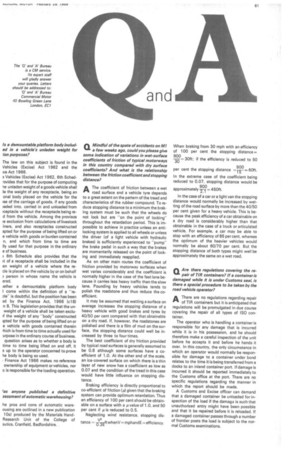Q Mindful of the spate of accidents on MI lah
Page 63

If you've noticed an error in this article please click here to report it so we can fix it.
a few weeks ago, could you please give some indication of variations in wet-surface coefficients of friction of typical motorways in this country compared with dry surface coefficients? And what is the relationship between the friction coefficient am: stopping distance?
A The coefficient of friction between a wet
^ road surface and a vehicle tyre depends to a great extent on the pattern of the tread and characteristics of the rubber compound. To reduce stopping distance to a minimum the braking system must be such that the wheels do not lock but are "on the point of locking" throughout the retardation period. This is impossible to achieve in practice unless an antilocking system is applied to all wheels or unless the driver (of a light vehicle with hydraulic brakes) is sufficiently experienced to "pump" the brake pedal in such a way that the brakes are momentarily released on the point of locking and immediately reapplied.
As on other main routes the coefficient of friction provided by motorway surfaces when wet varies considerably and the coefficient is normally higher in the case of the fast lane because it carries less heavy traffic than the slow lane. Pounding by heavy vehicles tends to polish the roadstone and thus reduce the coefficient.
It may be assumed that wetting a surface on average increases the stopping distance of a heavy vehicle with good brakes and tyres by 40/50 per cent compared with that obtainable on a dry road. If, however, the roadstones are polished and there is a film of mud on the surface, the stopping distance could well be increased by three to four times.
The best coefficient of dry friction provided by typical road surfaces is generally assumed to be 0.8 although some surfaces have a coefficient of 1.0. At the other end of the scale, an ice-covered surface on which there is a thin layer of new snow has a coefficient as low as 0.07 and the condition of the tread in this case would have little influence on stopping distance.
Braking efficiency is directly proportional to co-efficient of friction (u) given that the braking system can provide optimum retardation. Thus an efficiency of 100 per cent should be obtainable on a surface with a g value of 1.0, and 50 per cent if ,u is reduced to 0.5.
Neglecting wind resistance, stopping dis tance V2
0. Eft whenV= mphandE = efficiency
When braking from 30 mph with an efficiency of 100 per cent the stopping distance = 900 — 30ft: if f the efficiency is reduced to 50 900
per cent the stopping distance = = 60ft.
In the extreme case of the coefficient being reduced to 0.07, stopping distance would be
approximately -2-1-= 450ft.
In the case of a car or a light van the stopping distance would normally be increased by wetting of the road surface by more than the 40/50 per cent given for a heavy vehicle. This is because the peak efficiency of a car obtainable on a dry road is considerably higher than that obtainable in the case of a truck or articulated vehicle. For example. a car may be able to stop with an efficiency of 85 per cent, whereas the optimum of the heavier vehicles would normally be about 60/70 per cent. But the stopping distance of both types might well be approximately the same on a wet road.








































































































